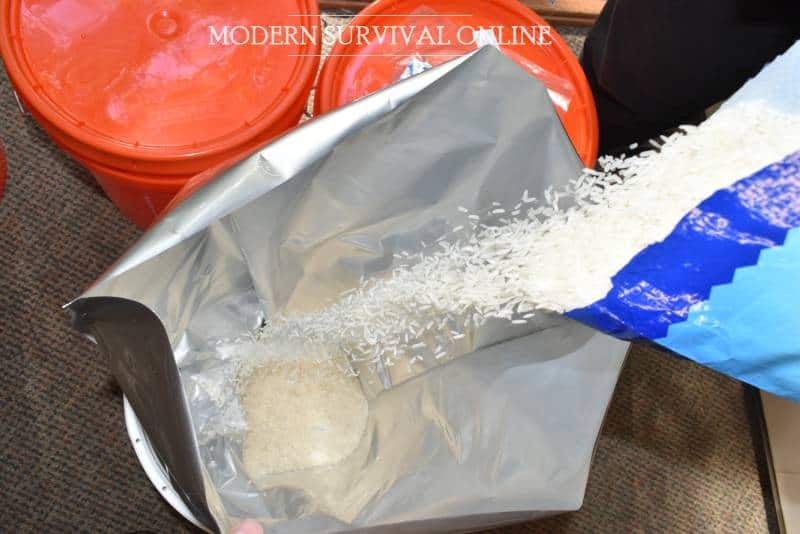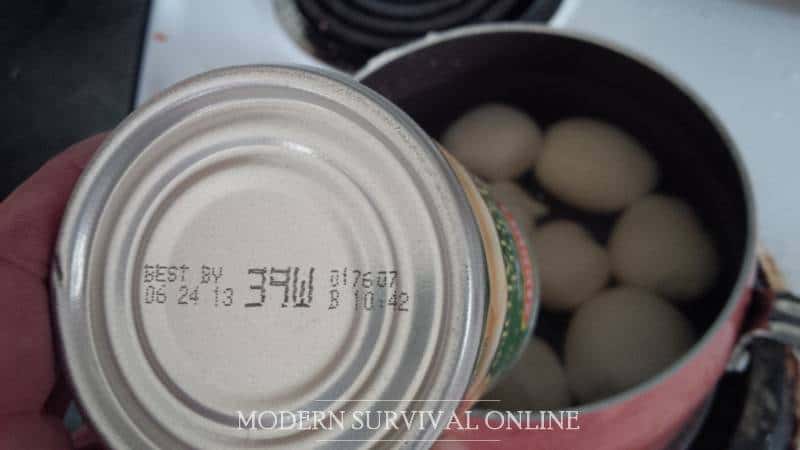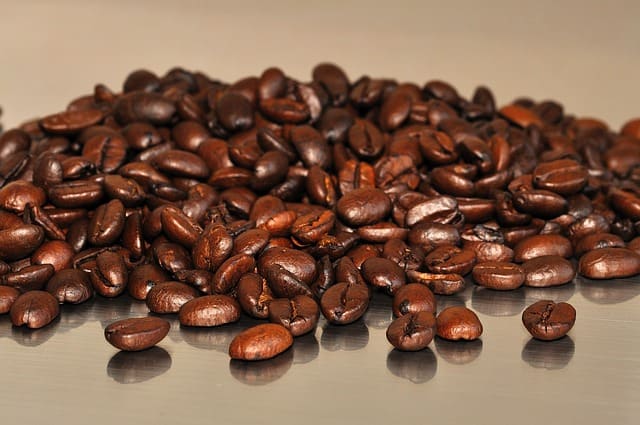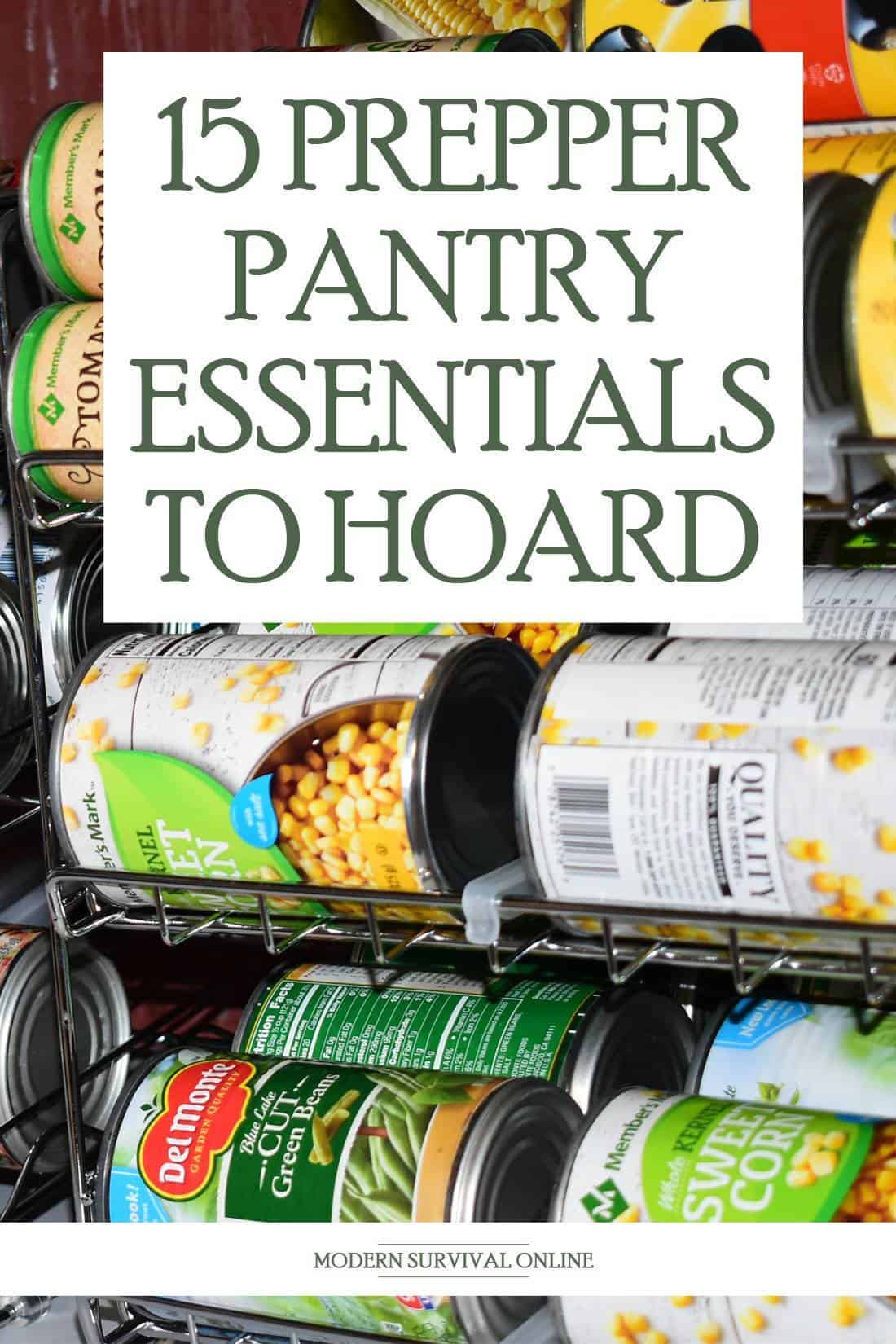One of the foundational elements of prepping is ensuring that you have enough provisions on hand for yourself, your family and anyone else that you care about to last through the disruption of society that occurs as the result of disaster or crisis.
Food, naturally, is never far from people’s thoughts and most of us don’t have to miss too many meals before we start falling apart mentally and emotionally.

Though some preppers are quick to point out that one can go many weeks without starving, they usually omit to point out that you will be physically and mentally deteriorating the entire time, greatly hampering your efforts to survive.
The solution for this unhappy outcome is simple: simply keep food on hand to ensure an adequate influx of calories to fuel hard-working bodies.
Though seasoned preppers will make use of all manner of preservation techniques for all kinds of foods, beginning preppers or those who want to simplify their logistics are wise to go with pantry-kept staples for long-term storage, all foodstuffs that require no special care.
In the article below we’ll be sharing with you 15 of the best picks for your pantry survival stockpile.
For your consideration, I have grouped our 15 pantry essentials for preppers into three categories: Staples, superstars and luxuries.
In the staples category are basic ingredients or foods that are highly essential to a well-rounded survival menu, to say nothing of a diet, but generally either serve as an ingredient in a more complex dish, as a foundation for a rudimentary side item, or something similar.
Superstars are foods that every prepper should turn to first as a foundational element of their survival stash. These are items that are, as a rule, easy to prepare and extremely potent nutritionally. Their long-keeping nature also eases concerns about rotation and spoilage and they can all be had in great abundance very cheaply.
Lastly we have the luxuries, items which are not strictly necessary nutritionally or otherwise but will help you stretch your existing items into more interesting culinary territory. Some of these items also have additional uses beyond the kitchen, and most of them make for excellent trade fodder should that situation arise.
Now that you know what goes where and why, let us get on to our list.
The Staples
Flour
Flour is such a foundational ingredient it is hard to imagine life without it. A critical component of breads and other baked goods, flour also serves to help give body and a higher caloric payload to everything from sauces to fried foods.
Flour is one of those things that is available in tremendous abundance and quite cheaply right now, but when the wheels come off of society and the commercial mechanisms that produce flour from yearly crops break down you may yet discover just how difficult it is to create it yourself.
Flour will keep for a long time if it is kept in ideal conditions, so make sure you keep yours in an airtight container that can protect against pests and also keep it out of very warm areas and direct sunlight in particular.
Also keep in mind that even a little bit of moisture infiltration, even prolonged exposure to high humidity, can quickly mold and rot your flour.
Honey
Most preppers have been in the game any length of time are already aware of the bodacious survival staple that is honey.
Delicious, nutritious and possessing an extraordinary, unbelievable shelf life, it is no exaggeration to say that honey will last effectively forever barring any contamination from pests or other nastiness. In fact, archaeologists have unearthed honey from Egyptian ruins that remained completely edible even after thousands of years.
This is not to say that honey does not have any special storage requirements, however. Any amount of air that infiltrates the container of your honey will begin to slowly crystallize it, turning it into a solid.
You can still eat it this way, but it will make it far more difficult to dispense and use in recipes. Not to worry, as you can convert it back to its semi-liquid state by immersing the container in hot water.
Another fun fact for preppers: honey has antiseptic qualities, and is useful for treating small cuts and lacerations as well as burns.
Salt
Salt is another staple so ubiquitous that it is difficult to imagine modern life without it. Salt seasons food, making it delicious and palatable but more importantly it also works as a potent preservative, meaning you might employ salt to preserve or further preserve cuts of meat and other foods. For this reason, you should have quite a large quantity of salt on hand at all times.
Beyond its typical culinary applications, salt is also an important electrolyte for the body and critical for regulating cellular processes. You can drink all the water you want, but when your body runs too low on salt, you’ll start to feel janky pretty quickly.
It is also worth noting that salt also works as a mild abrasive, and can allow you to thoroughly clean dirty dishes and other surfaces in conjunction with a damp rag, all without any chemicals. Check out more uses for salt here.
Sugar
Oh, sugar. There is hardly a more contentious ingredient in all the land. This wonderful, sweet substance has won and lost fortunes for people over the years.
Capable of producing immense satisfaction, tooth decay and weight gain in equal measure it is nonetheless an invaluable source of quick energy and calories, to say nothing of its emotional and mental boost it provides for those who eat it.
Sugar, along with flour, is a critical ingredient in baked goods and confections in particular. That being said, it is added in lesser quantities to many other dishes.
Sugar is one of those things that you might not miss until it is gone, being present in high quantities in all kinds of packaged and processed foods. Whatever you might feel about its health effects it is still an invaluable part of any prepping pantry.

Rice
Rice is a wonderful survival commodity, able to serve ably as a side dish, a main dish and even as a dessert, and is a delicious, versatile and well-rounded staple for breakfast, lunch and dinner.
You might not be a big fan of rice but it is hard to count it out considering its nutritional value, stability and calorie payload. Was just a little bit of boiling water you are off to the races.
There are many kinds of rice out there, and most folks aren’t familiar with any variety in the US beyond what comes in a box out of some aisle in the middle of a supermarket.
Consider looking for large sacks or buckets of whole grain rice at Asian and health food supermarkets for best nutrition and shelf life.
Also, rice is one of those foods that rarely comes in a container that is best suited for long-term storage, so don’t be afraid to transfer it into a better vessel for the task.
The Superstars
Peanut Butter
I’ll tell you; anyone who doesn’t like peanut butter is cold, cruel and un-American! Okay, I might be laying it down on a little thick but the truth is that peanut butter has an awful lot to commend it as a survival food, both as a primary source of sustenance and as a condiment or ingredient.
It is long-lasting, completely shelf stable with no refrigeration and packed full of protein, vitamins, minerals and fats. It is not a truly complete meal replacement but it is getting awfully close, and you can survive for a very long time on little more than an extra large jug of peanut butter.
Even better, peanut butter is cheap and plentiful, so if you’re worried about raw calories and basic nutrition you could do a lot worse than leading the stuffing of your survival stash with a few large canisters of the stuff.
Not for nothing, peanut butter is also a primo ingredient for making various trail foods and other easy to transport, stable and calorie dense rations. No wonder so many survival experts think so highly of this delicious butter!
Beans, Dry
Beans are yet another survival provision that have earned their place among the very best foods that one can store for rough times. Beans are extremely filling, packed with nutrition and simple to prepare, though they do require a lot of water and a fair bit of time to do so.
Beans can be eaten as a meal by themselves, added to soups and stews or as a delicious side dish prepared in any number of ways for any kind of cuisine.
Budget-conscious preppers will be happy to hear that beans are among the very best “bang” for your nutritional buck, calories included.
Dry beans stored in ideal conditions can last for years and years, though old or stale beans can sort of “fossilize” and will have to be rigorously boiled to make them palatable again. Despite these few drawbacks beans should still be a prime mover for your survival rations.

Canned Goods
You don’t have to stock strictly staples to be prepared for rough times as a prepper. There is an awful lot to recommend conventional canned goods that you buy at the grocery store for the purpose.
Major advantages include an excellent selection of fruits, vegetables and meats that are ready to eat with minimal or no preparation and lengthy shelf lives that will minimize rotation requirements.
Disadvantages include size, weight, form factor and it cost-per-calorie but for comparatively short-term situations canned goods are just fine, and also have the advantage of being packed moist or wet to help keep you hydrated.
This is a broad category, obviously, and everyone has their favorites. Good options that you might consider are the usual stuff like fruits and vegetables, but definitely don’t skimp out on the canned meat, meats like chicken, tuna and Spam.
Spam is the butt of many jokes, but the joke is on you if you omit this protein packed favorite! You might consider including a few cans of soup or stew, but it is far less nutritionally dense than you might be thinking.
Consider this a comfort food option for morale boosting, and remember you can always make your own soups with a minimum of fuss so long as you have the prerequisite ingredients.
Pasta
Good pasta is truly one of life’s pleasures. There is hardly anything more satisfying or comforting than a big bowl of warm pasta brimming with all the delicious ingredients you want, all slathered in homemade sauce. But for survival purposes consider pasta as the equivalent of long-shelf life bread.
Supremely affordable, packed with calories and containing a reasonable assortment of minerals, pasta kept in ideal conditions can last for at least a year, easily.
Like many other goods included on this list, pasta takes a considerable amount of boiling water to prepare properly, and water might be at a premium depending on your circumstances and current level of preparation.
Also don’t forget you’ll need plenty of fuel to sustain boiling temperature while the pasta cooks, so if you are concerned about your ability to produce water or bring it to a boil in the aftermath of a major crisis, you might want to choose something else.
Wheat
Wheat, actual wheat berries, not wheat flour, is a commonly overlooked food stuff that is more than worthy of inclusion and your survival food plan.
Wheat berries can of course be dried and ground into flour, but they make for a delicious side dish or breakfast option when boiled and dressed up with some seasonings and spices.
Filling, calorie-dense and surprisingly tasty this is a good alternative for people who hate rice or are getting sick of oatmeal.
Naturally, finding wheat berries on the shelf at your local grocery is anything but a sure bet, so be prepared to procure some directly from the source or seek out a specialty retailer to get them in quantity.
The Luxuries
Oils
Dietary fats are necessary for survival, make no mistake, and more practically fats provide a boatload of calories in a very small package. They also greatly enhance the flavor of all kinds of foods.
In most modern kitchens fats are usually added to foods in the form of oils, particularly plant-based oils such as the ever-popular olive, canola and vegetable varieties.
Oil is an essential ingredient in many recipes, a helpful agent to prevent sticking when cooking and a great way to add a big shot of calories with a small amount of resources.
Oils that are kept out of direct sunlight, stored at room temperature and kept in a container that minimizes internal air volume will last for a very long time, easily a year or more. However, take care because oils can both evaporate and go rancid, spoiling them.
The latter occurrence is far more likely if you allow the oil to become contaminated by contact with your skin, direct contact with food or by allowing it exposure to direct sunlight. Take the care and time needed to pamper your supply of cooking oil and it will go the distance!
Vinegars
Vinegars might not provide much in the way of calories, but they can provide a big boost of flavor in a variety of dishes, and also have great utility for preserving fruits and veggies through pickling and also around the home as a disinfectant. Certain vinegars even work well for various medicinal purposes and relieving a variety of ailments.
Vinegars are another one of those items in your pantry that seemingly never expire, although they can degrade over a long period of time.
If you have a brand new bottle of vinegar that you keep sealed and, once again, keep out of direct sunlight and at approximately room temperature it will last for a very long time with no need to rotate even on a yearly basis.
Balsamic vinegar is a sure bet for cooking, but a prepper’s powerhouse pick is white vinegar; equally handy for various chores and also suitable for use in cooking and pickling.
Spices
It is morbidly funny to think that wars have been fought over spices in ages past- tens of thousands, even hundreds of thousands of people laid low and brought to their deaths over these delectable little plants that we can buy by the ton in any grocery store. Alas.
Considering our survival pantry, spices are not strictly necessary since most of them have no caloric content whatsoever and may only provide tangential nutrition in the form of vitamins and minerals. However, their primary benefits still make them worthy of inclusion on our list.
Spices help give any dishes you prepare depth, texture, flavor and interest. Spicing up a mundane and simple offering might transport it into an entirely new realm of enjoyment, and since variety is, well, the spice of life this can be a great morale booster for people who would otherwise be stuck eating more or less the same few dishes every few days.
This boost to morale should not be underestimated, nor should the value of spices as a trade good during a long-term societal collapse situation.

Coffee
For a particular segment of the audience I probably did not even need to mention coffee for inclusion into the survival pantry.
For those that cannot get through their day with the rest of humanity without a little bit of “bean juice”, this was likely the first thing they stockpiled in quantity!
All jokes aside, coffee, particularly in whole bean form, has an excellent shelf life and is easy to keep like most of your other pantry goods.
The typical preparation of coffee does not provide any calories but what is does provide is precious, life-sustaining caffeine. When you need a little pick-me-up after a hard day on watch or a comforting warm drink after a harrowing experience.
Considering you’ll probably be dealing with lots of both, a reliable source of caffeine will be valuable and, like spices and other luxuries, is a great asset for bartering.
Tea
Tea, much like coffee, is not an essential good but it is a luxury, one with excellent practical benefits. Compared to “jitter liquid,” tea provides a much lighter payload of caffeine and also has components that promote relaxation and peace of mind.
Whatever you think about its mood altering chemicals, a hot cup of tea is always a great way to relax and relieve some stress.
Also like coffee, tea is easy to keep for a very long time when it is stored appropriately, and despite what tea snobs will say about the culture of cheap, low grade bagged tea it will keep for quite a long while in the plastic wrapped boxes you snag off the grocery store shelf. Again, like coffee, tea also makes for a good trade item if you don’t drink it yourself.
Storage Considerations
One thing every prepper should keep in mind when it comes to padding their pantry is that you don’t get a “free pass” on storage requirements just because the items you are storing are dry goods, or don’t require refrigeration.
Making that mistake means that the foodstuffs you have spent time and money accumulating could spoil or otherwise go bad far quicker than they would normally.
Depending on the configuration of your house, the quality of your insulation, the prevailing climate and other factors your pantry could get toasty inside, and that could accelerate the breakdown of certain items, particularly canned goods, flour and oils.
As a general rule, cool, dark and completely protected from direct sunlight is what you should be striving for.
Room temperature means different things to different people, so to remove any ambiguity or doubt on the matter install a small thermometer in your pantry so you know exactly what you are dealing with at different times of the day and in different seasons. This will allow you to make informed decisions, particularly when it comes to rotation intervals.
Another obstacle for long-term storage you must be aware of is pests. Rodents and insects in particular can infest dry goods like flour, rice, grains and beans, although any food that is in any packaging they can infiltrate or tear open is vulnerable.
Rodents in particular can be shockingly intrusive and persistent, and they’re extraordinary sense of smell means they will home in on your stash with unerring accuracy. Keeping them out of your food is usually a matter of perimeter control and elimination procedures, but don’t be afraid to put your items in metal containers if required.
Don’t Minimize the Emotional Value of a Varied Menu
One mistake I often see well-meaning preppers making when it comes to storing large amounts of food for long-term survival situations is an over-reliance on just a few items, staples or otherwise, with the notion that this will simplify logistics and that they are going to be roughing it for the duration, no matter what happens.
This harsh, almost ascetic method of preparation might be well intentioned, but I believe is misguided.
I believe as much because it completely omits one of the most important factors in the context of the event: the human factor. Like it or not, most people are not automatons or snake-eating hardasses that can do absolutely whatever is necessary for as long as necessary without mentally or emotionally breaking down. One surefire way to annoy, agitate and eventually enrage a person is to subject them to an unchanging, bland diet.
It doesn’t make sense to do that when you have all the time in the world to assemble a workable, sustainable and varied menu right now with just a little bit of extra effort.
Even though you might not always have the time or resources to put together, a proper three-course serving for every meal of the day, the ability to give people a menu that more or less mirrors what they would be having in kinder times will do much to ground them emotionally and improve their morale overall.
Before you brush this off as softness or butterfly chasing, remind yourself that the business of survival is a mental game first and foremost, and that anything you can do to improve the situation on that front is effort well spent.
Conclusion
Stockpiling food for a survival situation does not necessarily mean you’ll be eating bland, tasteless fare at every meal and also doesn’t mean you have to overinvest and complicated methods of preservation.
Your pantry alone is more than capable of holding a varied and nutritious assortment of foods for the purpose so long as you choose those items with care. Review the list above and you’ll find several items at the very least that warrant inclusion in your survival food plan.


Like what you read?
Then you're gonna love my free PDF, 20 common survival items, 20 uncommon survival uses for each. That's 400 total uses for these dirt-cheap little items!
We will not spam you.
Yeast
I’d like to know where you got the canned goods racks?
You mention wheat berries, but I’d also encourage you to branch out to other grains and cereals. I’ve stored up spelt and kamut, oat groats, buckwheat, millet, rye berries, and a few others. I often throw them in with white rice into the rice cooker, which does a good job. The textures are a nice consideration.
Another advantage is storage life. I’ve had these in tupperware-ish containers for over 12 years and they are all still as good as fresh.
Whole millet and whole amaranth are also nice to to add crunch to baked goods (for those allergic to nuts, or just because they are cheaper. Have also used in place of “breadcrumbs” to make recipes gluten free for those who need it.) 🙂 Never thought of mixing anything other than quinoa with rice, interesting.